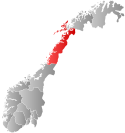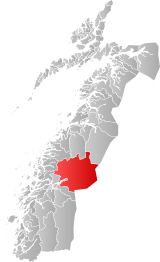|
Nord-Rana Municipality
Nord-Rana (historically: Mo) is a former municipality in Nordland county, Norway. The 3,980-square-kilometre (1,540 sq mi) municipality existed from 1839 until its dissolution in 1964. From 1839 until 1844, it was named Nord-Ranen Municipality, from 1844 until 1923, it was called Mo Municipality, and then from 1923 until 1964 it was named Nord-Rana Municipality. The former municipality was located at the innermost part of the Ranfjorden. It encompassed the eastern 90% of what is now Rana Municipality. The administrative centre was the village of Ytteren, just north of the town of Mo i Rana.[6][7]  Prior to its dissolution in 1964, the 3,980.8-square-kilometre (1,537.0 sq mi) municipality was the 4th largest by area out of the 689 municipalities in Norway. Nord-Rana Municipality was the 64th most populous municipality in Norway with a population of about 10,648. The municipality's population density was 2.7 inhabitants per square kilometre (7.0/sq mi) and its population had increased by 42.3% over the previous 10-year period.[8][9] General informationRana Municipality was established on 1 January 1838 under the old formannskapsdistrikt law. Shortly afterwards, in 1839, the municipality was divided into Nord-Ranen Municipality and Sør-Ranen Municipality.[6] In 1844, Nord-Ranen Municipality was renamed Mo Municipality. On 1 January 1923, the village of Mo was designated as a ladested and so it was separated from the rest of the municipality to become a town-municipality of its own. The new town of Mo (population: 1,305) kept the name Mo and the rest of the old municipality became known as Nord-Rana Municipality (bringing back the old name for the area).[10] During the 1960s, there were many municipal mergers across Norway due to the work of the Schei Committee. On 1 January 1964, Nord-Rana Municipality (population: 11,636) was merged with the town of Mo i Rana (population: 9,616), the part of Sør-Rana Municipality located north of the Ranfjorden (population: 697), and the Sjona area of Nesna Municipality (population: 543) to create the large, new Rana Municipality.[10] NameThe municipality is named Nord-Rana. The first element is nord which directly translates to "northern". The second element is Rana which comes from the local river Ranelva (Old Norse: Raðund). The name of the river is probably derived from the word raðr which means "quick", "fast", or "rapid". Another possibility is that the name comes from the old Sami god Rana Niejta.[11][12] GeographyThe highest point in the municipality was the 1,589.26-metre (5,214.1 ft) tall mountain Snøtinden.[1] The former municipality was located at the innermost part of the Ranfjorden. Saltdal Municipality, Beiarn Municipality, and Meløy Municipality were located to the north; Rødøy Municipality and Nesna Municipality were located to the west; Sør-Rana Municipality was located to the southwest; and the nation of Sweden was located to the east. The self-governing town of Mo was located within Nord-Rana Municipality as an enclave. GovernmentWhile it existed, Nord-Rana Municipality was responsible for primary education (through 10th grade), outpatient health services, senior citizen services, welfare and other social services, zoning, economic development, and municipal roads and utilities. The municipality was governed by a municipal council of directly elected representatives. The mayor was indirectly elected by a vote of the municipal council.[13] The municipality was under the jurisdiction of the Hålogaland Court of Appeal. Municipal councilThe municipal council (Herredsstyre) of Nord-Rana was made up of 35 representatives that were elected to four year terms. The tables below show the historical composition of the council by political party.
MayorsThe mayor (Norwegian: ordfører) of Nord-Rana was the political leader of the municipality and the chairperson of the municipal council. Here is a list of people who held this position:[20][21]
See alsoReferences
|
|||||||||||||||||||||||||||||||||||||||||||||||||||||||||||||||||||||||||||||||||||||||||||||||||||||||||||||||||||||||||||||||||||||||||||||||||||||||||||||||||||||||||
Portal di Ensiklopedia Dunia


